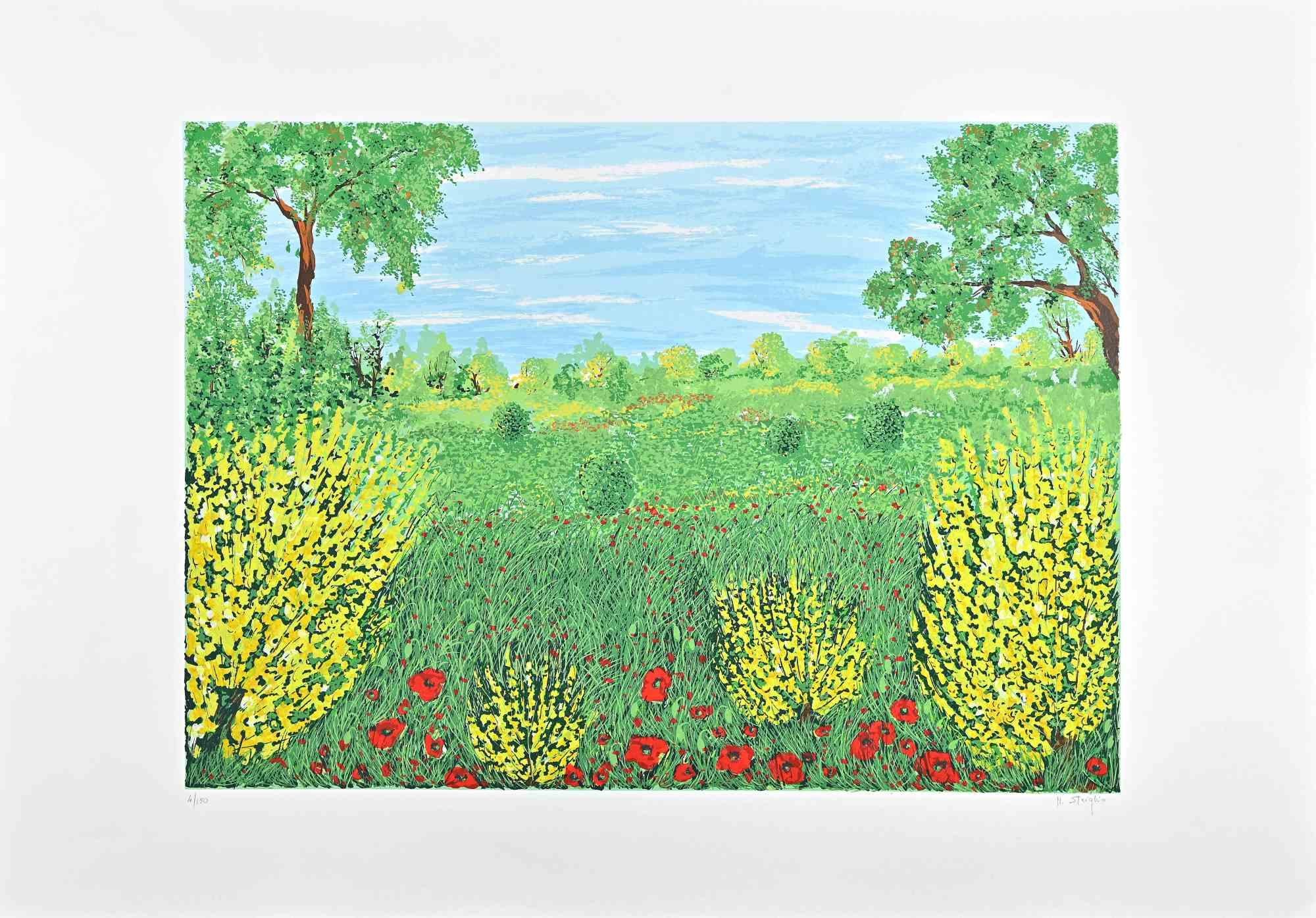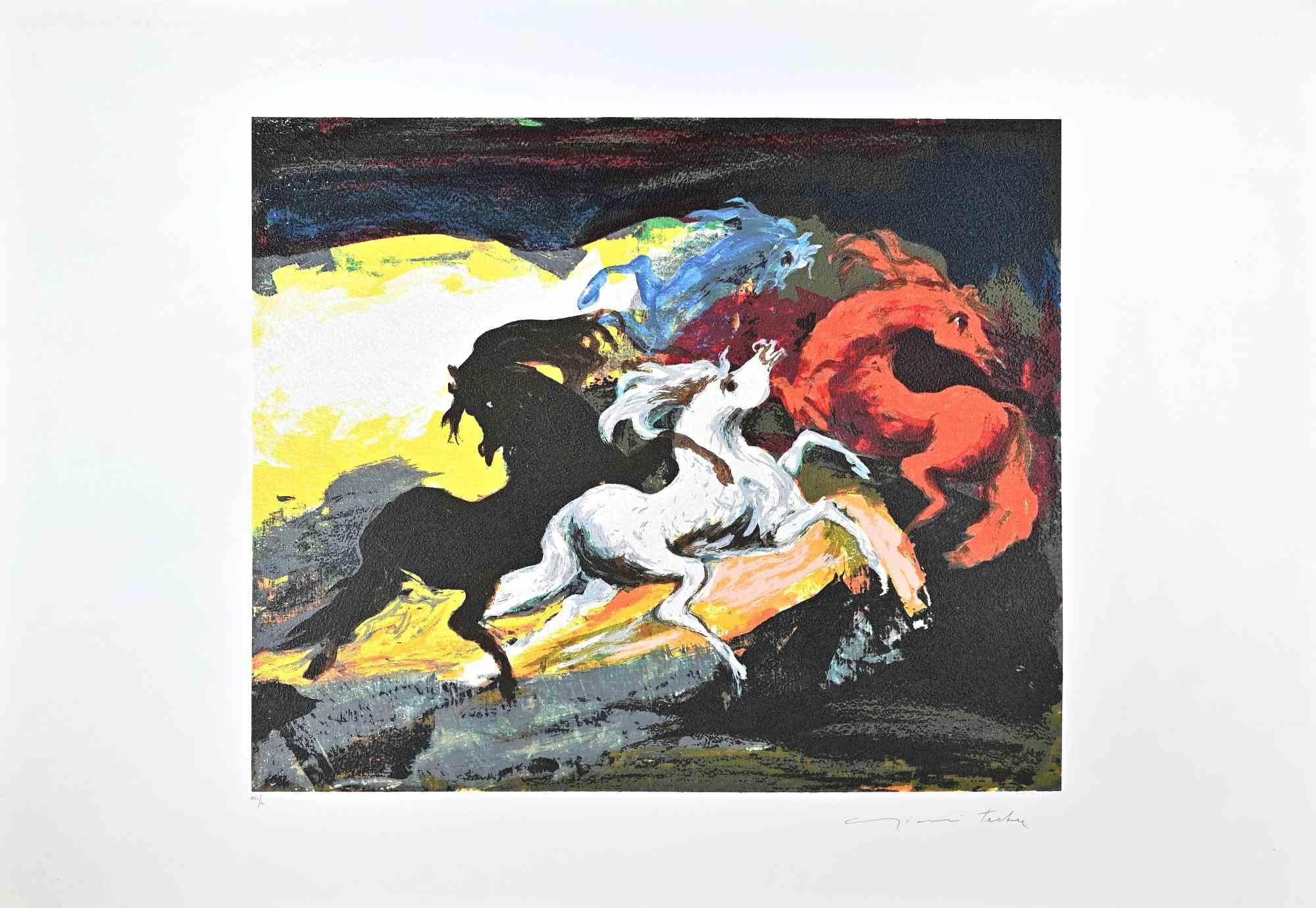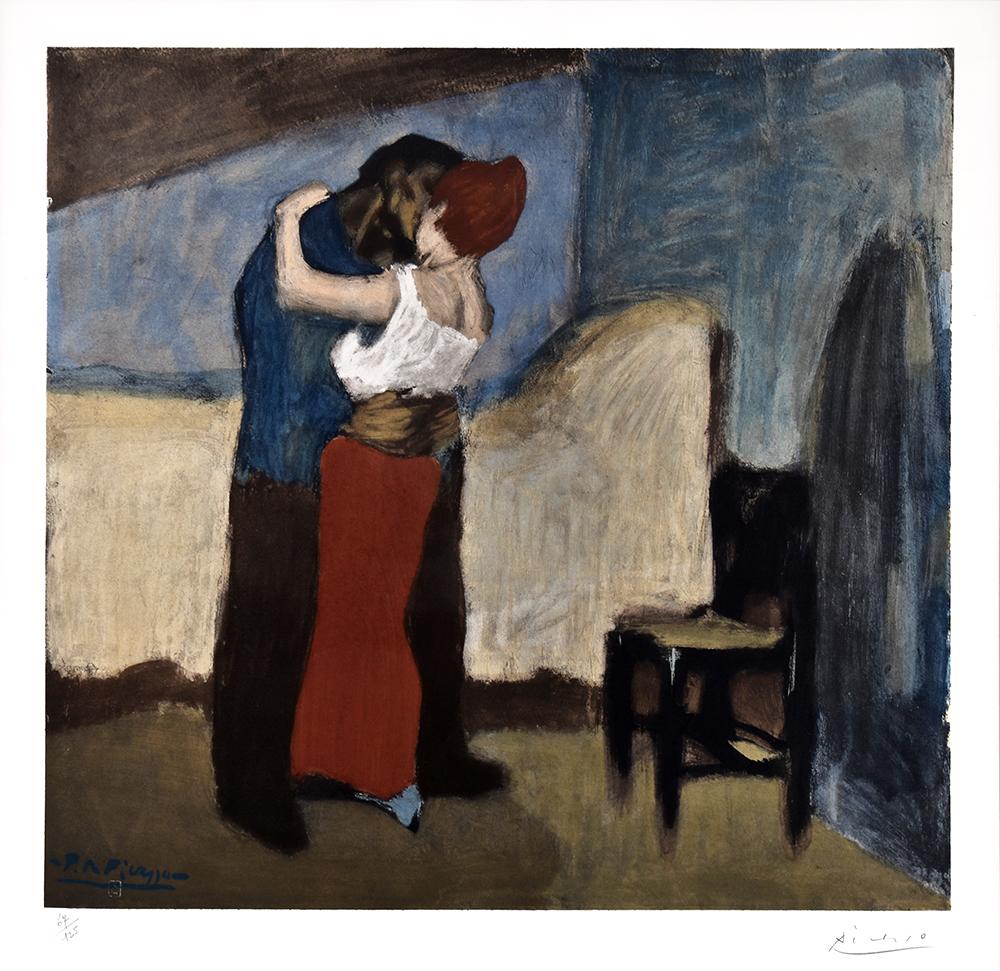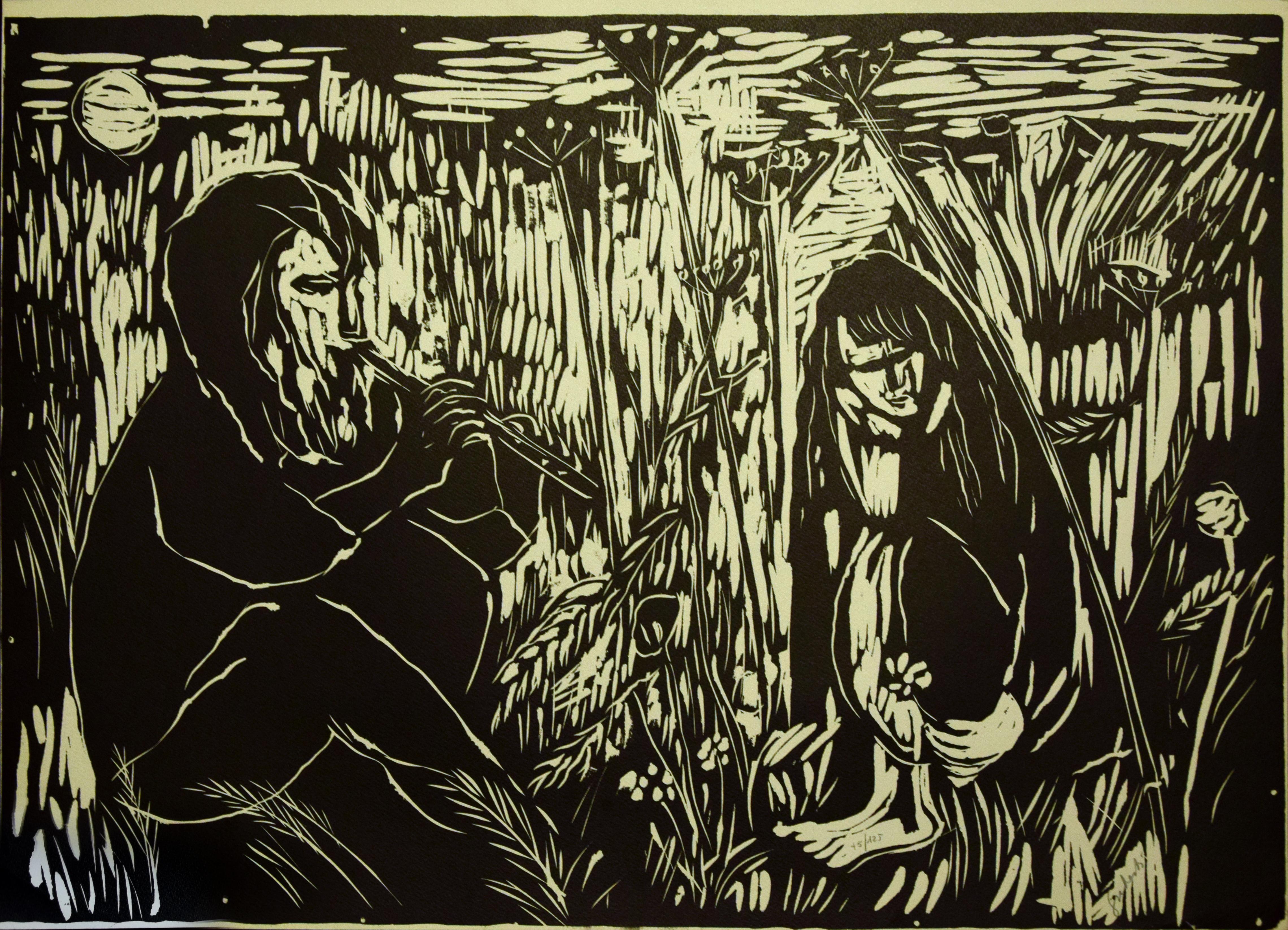Items Similar to Bali Princess (variant green)
Want more images or videos?
Request additional images or videos from the seller
1 of 9
Ting Shao KuangBali Princess (variant green)1996
1996
About the Item
This artwork titled "Bali Princess" variant green, 1996, is an original color serigraph on thin rice paper taped to a sheet of wove paper for stabilization by noted Chinese artist Ting Shao Kuang, b.1939. It is unsigned as issue. There is a hand signed and numbered edition with the same image with a different background. The artwork (image) size is 24 x 23 inches, rice paper sheet is 28.5 x 28 inches, backing wove paper sheet is 31.5 x 29 inches. This artwork is a trial (test) proof. The printer will print the same subject in different colors combination for the artist to select the one he want for producing the final signed and numbered edition. Only 2 copies with these particular colors and background design where printed. It is in excellent condition, the margin is slightly wavy,
About the artist:
Ting Shao Kuang, a prominent contemporary Chinese painter in America, has produced works characterized by a combination of traditional Chinese painting techniques and the more expressive Western art forms. He has created a unique style that does not belong exclusively to the East or the West, but to the world.
Ting Shao Kuang was born in Chenggu, a village located in the Northern province of Shanxi, China in 1939. The year Ting was born, this area, which once was the center of an advanced civilization, was reeling from the ravages of the Sino-Japanese war. But as the war progressed, Ting's father, a Kuomintang official in Beijing, helped rally the Nationalist forces, and the Japanese Imperial Army was eventually defeated. Mao Zedong's People's Liberation Army took over the government of China only two years after the war, forcing Ting's parents to flee to Taiwan. They left Ting in Beijing with his grandparents who were suffering immensely from the poverty that was inflicted upon them by the Government.
In order to survive his loneliness and alienation, Ting turned to painting for solace. By age 11, he was painting every day, using cooking oil as a medium for his pigment. Despite his lack of adequate supplies, he evidenced such remarkable talent that, in 1954, he was given the opportunity to attend the prestigious high school affiliated with the Central Academy of Fine Arts in Beijing.
In 1957, Ting was accepted at Beijing's Central Academy of Arts and Crafts. Although he was taught "Socialist Realism" in his classes, it was during this time that he discovered the works of Picasso, Matisse and Modigliani. The paintings of these artists inspired him to experiment with new themes and techniques. The summer before he began his senior year, Ting went to the Yellow River to paint the birthplace ofChinese civilization. However, when he arrived he found such misery and poverty, due to the disastrous Great Leap Forward, that he returned to Beijing. Because of the impact his trip had on him, he committed himself to painting only the beautiful side of life.
After graduating in 1962 with highest honors, Ting was signed to teach at the Yunnan Art Institute in Kunming. Here he painted during the night in an abstract style that was considered unacceptable by the government. This forced him to burn his paintings each morning to avoid being caught by the authorities. Although the people in Kunming had more freedom than Ting had ever known, his modernistic views still managed to come to the attention of the authorities. As a result, in 1967, he was suspended from his job and, when rumors of his impending imprisonment reached Kunming, he escaped into northern China. He found sanctuary in the Buddhist monasteries of Gansu where he studied the ancient sculptures they contained. Later he went to Dunhuang , an ancient caravan stop of the Silk Route from 4th to the 13th century, where he studied the paintings preserved on the walls and ceilings of over four hundred caves.
In 1968, Ting felt it was safe to return to Kunming even though it was mandatory to attend political meetings and it was still impossible for him to teach. By that time, however, there were four other artists there who shared his artistic views. After Mao died in 1976 and art classes finally resumed, the friendship that began in secret slowly began to surface. In 1979, these artists formed the Yunnan Shen She Art Association and, three years later, they exhibited at the First International Art Show in Hong Kong. In the same year, Ting was commissioned to paint a mural in the Great Hall of the People, which was an extraordinary honor for any artist, especially one who was considered to be an outsider, philosophically.
Living in the United States since 1980, Ting Shao Kuang has had more than one hundred personal exhibitions in America, Japan, Canada, Greece, Hong Kong and Taiwan, and has become a force in the international art world. Ting's purposeful marriage of ancient art customs, masterful brush strokes, and calligraphic lines, mixed with the starkness and beauty of modernism, have made his works some of the most recognizable in the world. He is considered a world-renowned leader of the Yunnan School by the American art critic Douglas Finly. Japanese art critic Murobushi thinks him an exceptionally authentic Chinese artist, and French art critic Andre Parinaud once commented that "His art has a timeless exuberance, and its exultation of love has turned him into a 20th century Giotto"
- Creator:Ting Shao Kuang (1933, Chinese)
- Creation Year:1996
- Dimensions:Height: 31.5 in (80.01 cm)Width: 29 in (73.66 cm)Depth: 0.01 in (0.26 mm)
- Medium:
- Movement & Style:
- Period:
- Condition:
- Gallery Location:San Francisco, CA
- Reference Number:
Ting Shao Kuang was born in 1939, in Chenggu, a small village located in the Northern province of Shanxi, China. His earliest childhood was marked by the horrors of the Sino-Japanese war that destroyed his land and left him abandoned after the evacuation of his parents to Taiwan. He found his consolation and escape in painting and by the age of 11, he painted on a daily basis, using the cooking oil as a medium for the pigment. Even besides his limited supplies, Ting Shao Kuang managed to use his extraordinary talent and got the opportunity to attend a prestigious high school which was connected with the Beijing’s Central Academy of Arts and Crafts where he later gained his further education. His painting lessons were based on rules of Social Realism without freedom of expression and with the strict prohibition of any foreign influences. After graduation in 1962, Kuang obtained a position to teach at the Yunnan Art Institute in Kunming. Painting the unacceptable abstract paintings during the night, he would destroy every piece of them in the morning, fearing of the arrestment of the authorities of the country. Still, Ting Shao Kuang’s progressive and modern vision did not fail to attract the attention and he was suspended from his work and escaped to northern China, finding the refuge in Buddhist monasteries in Gansu where he studied ancient sculpture and cave paintings on the old Silk Route which had been preserved for centuries.
Using the distinctive technique, Ting Shao Kuang’s work combines traditional Chinese influences with the Western art forms. Always turning to the female characters as his favorite subjects, their sophisticated shapes have been created from the artist’s deepest feelings and literature that inspired him. After the death of Mao, Kuang and his colleagues founded the famous Yunnan Shen She Art Association and the artist got his first big commission to paint a mural in the Great Hall of the People. Although the achieved the success and recognition in his country, Ting Shao Kuang decided to try the luck in the United States. Living in the Los Angeles since 1980, his work has been exhibited in numerous shows worldwide.
About the Seller
5.0
Platinum Seller
These expertly vetted sellers are 1stDibs' most experienced sellers and are rated highest by our customers.
Established in 1999
1stDibs seller since 2017
685 sales on 1stDibs
Typical response time: 1 hour
- ShippingRetrieving quote...Ships From: San Francisco, CA
- Return PolicyA return for this item may be initiated within 7 days of delivery.
More From This SellerView All
- HomerBy Valerio AdamiLocated in San Francisco, CAThis artwork titled "Homer" 1979 is an original colors serigraph on Stonehenge Wove paper by noted Italian artist Valerio Adami, b.1935. It is hand signed and numbered 6/75 in pencil by the artist. Published by Editions Press, San Francisco. The image size is 37.5 x 21.75 inches, framed size is 45.75 x 29.15 inches. Custom framed in a metal gold frame, with beige fabric matting. The artwork is in excellent condition, the frame is in very good condition, it has some minor scratches. About the artist: Valerio Adami was born in Bologna. In 1935, at the age of ten, he began to study painting under the instruction of Felice Carena. He was accepted into the Brera Academy (Accademia di Brera) in 1951, and there studied as a draughtsman until 1954 in the studio of Achille Funi. In 1955 he went to Paris, where he met and was influenced by Roberto Matta and Wifredo Lam. His first solo exhibition came in 1959 in Milan. In his early career, Adami's works were expressionistic, but by the time of his second exhibition in 1964 at Kassel, he had developed a style of painting reminiscent of French cloisonnism, featuring regions of flat color bordered by black lines. Unlike Gauguin, however, Adami's subjects were highly stylized and often presented in fragments, as seen in Telescoping Rooms (1965). In the 1970s, Adami began to address politics in his art, and incorporated subject matter such as modern European history, literature, philosophy, and mythology. In 1971, he and his brother Gioncarlo created the film Vacances dans le désert. In 1974 he illustrated a Helmut Heissenbuttel poem, Occasional Poem No. 27. Ten Lessons on the Reich with ten original lithographs {Gallerie Maeght...Category
Late 20th Century Modern Figurative Prints
MaterialsScreen
- ToastLocated in San Francisco, CAThis artwork titled "Toast" c.1990, is an original color serigraph by American artist Rickey Jewell Hohimer, 1946-2021. It is hand signed, titled and numbered 98/300 in pencil by the artist. The image size is 23.75 x 9.5 inches, framed size is 30.25 x 16.25 inches. The artwork is in excellent condition, the frame is slightly damaged, and will be replaced by a new similar black frame when sold. This will bring the over all condition to excellent. About the artist: Although formally trained with a MFA in painting, Rickey Jewell Hohimer has used the styles of Van Gogh and Gaughin to reach for the spontaneity and simplicity of today's folk art. Hohimer creates figures which are not photos of reality; they are romantically stylized to encourage straightforward emotional responses both to the colorful images and to the situations in which they find themselves. Each of Hohimer's paintings lays out a basic story line to which viewers add their own details. "I want the viewer to become personally involved. My paintings offer a change from those which encourage extensive intellectualizing about what the artist is trying to convey. I want viewers to smile -- to enjoy the whimsical nature of what they are experiencing -- to feel it, not to analyze it. His jazz paintings are stories on canvas of inspired musicians spontaneously making music of the moment. Life in the jazz age is clubs and nightlife beckoning to musicians to produce jazz art...Category
Late 20th Century American Modern Figurative Prints
MaterialsScreen
- II Cup of JoeLocated in San Francisco, CAThis artwork titled "II Cup of Joe" c.1990, is an original color serigraph by American artist Rickey Jewell Hohimer, 1946-2021. It is hand signed, titled and numbered 250/300 in pencil by the artist. The image size is 19.5 x 23.5 inches, framed size is 26.75 x 30 inches. The artwork is in excellent condition, the frame is slightly damaged at the top, and will be replaced by a new similar black frame when sold. This will bring the over all condition to excellent. About the artist: Although formally trained with a MFA in painting, Rickey Jewell Hohimer has used the styles of Van Gogh and Gaughin to reach for the spontaneity and simplicity of today's folk art. Hohimer creates figures which are not photos of reality; they are romantically stylized to encourage straightforward emotional responses both to the colorful images and to the situations in which they find themselves. Each of Hohimer's paintings lays out a basic story line to which viewers add their own details. "I want the viewer to become personally involved. My paintings offer a change from those which encourage extensive intellectualizing about what the artist is trying to convey. I want viewers to smile -- to enjoy the whimsical nature of what they are experiencing -- to feel it, not to analyze it!. His jazz paintings are stories on canvas of inspired musicians spontaneously making music of the moment. Life in the jazz age is clubs and nightlife beckoning to musicians to produce jazz art...Category
Late 20th Century American Modern Figurative Prints
MaterialsScreen
- Religion and PeaceLocated in San Francisco, CAThis artwork titled "Religion and Peace" 1995, is an original color serigraph on thin rice paper taped to a sheet of wove paper for stabilization by noted Ch...Category
Late 20th Century Modern Figurative Prints
MaterialsScreen
- Ancient CivilizationLocated in San Francisco, CAThis artwork titled "Ancient Civilization" 1996, is an original color serigraph on thin rice paper taped to a sheet of wove paper for stabilization by noted ...Category
Late 20th Century Modern Figurative Prints
MaterialsScreen
- Bali Princess (variant red)Located in San Francisco, CAThis artwork titled "Bali Princess" variant red, 1996, is an original color serigraph on thin rice paper taped to a sheet of wove paper for stabilization by ...Category
Late 20th Century Modern Figurative Prints
MaterialsScreen
You May Also Like
- Aries - Screen Print by Sergio Barletta - 1973By Sergio BarlettaLocated in Roma, ITAries is a screen print on grey paper realized by Sergio Barletta in 1973. 68 x 49 cm Two folds in the top margin of the sheet. Sergio Barletta (1934) is an Italian cartoo...Category
1970s Modern Figurative Prints
MaterialsScreen
- L’étreinte (The Embrace)By (after) Pablo PicassoLocated in Palo Alto, CAPablo Picasso L’étreinte (The Embrace), 1966 depicts the influence art nouveau and impressionism has on Picasso’s early works, a precursor to the artists rapidly approaching arrival ...Category
1960s Modern Figurative Prints
MaterialsScreen
- The Sorrel - Original Screen Print by Gianni Testa - 1986By Gianni TestaLocated in Roma, ITThe Sorrel is an original print realized by the Italian artist Gianni Testa in 1986. Original mixed colored screen print. Hand-signed by the artist on the lower left. Numbered on...Category
1980s Modern Figurative Prints
MaterialsScreen
- Explosive Spring -Original ScreenPrint by Maddalena Striglio - Late 20th centuryLocated in Roma, ITExplosive Spring is a very brightly colored screen print realized by the contemporary Italian artist Maddalena Striglio in the late 20th Century. ...Category
Late 20th Century Modern Landscape Prints
MaterialsScreen
- Erté (Romain de Tirtoff) - Manhattan Mary IV: serigraph Broadway musicalBy ErtéLocated in London, GBErté (Romain de Tirtoff) (1892-1990) 'Manhattan Mary IV' Serigraph (Silk screen print) (Artist's Proof IL/L) Signed in pencil 70 x 56cm (sheet) 41.5 x 3...Category
1920s Modern Figurative Prints
MaterialsScreen
- Piper - Guberti - 1970s - Serigraph - ModernLocated in Roma, ITPiper is an original artwork realized by Guberti in the 1970s. Hand-signed in pencil on the lower right by the artist. Good conditions, except for a fold of paper on the lower left. ...Category
1970s Modern Figurative Prints
MaterialsScreen





